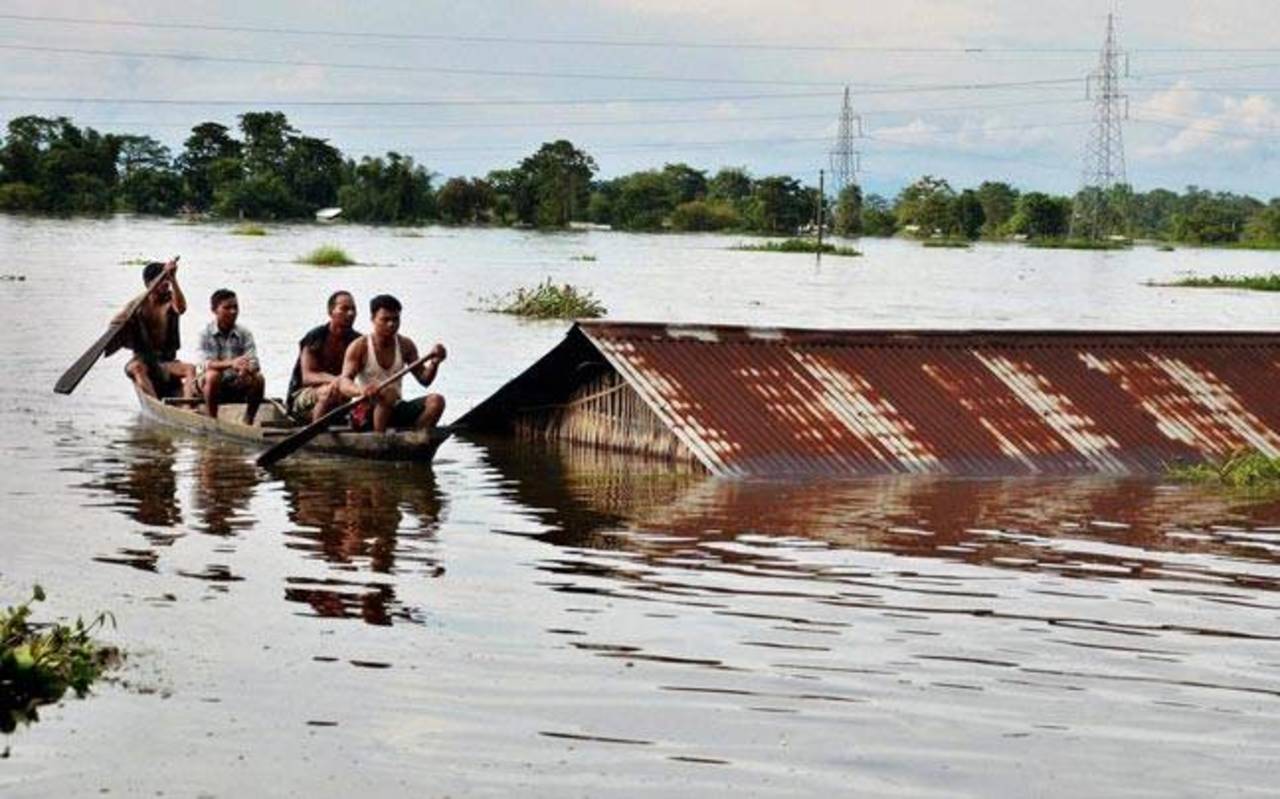14,000 in relief camps: Nearly 5 lakh hit, one dead as Assam flood situation worsens
The monsoon hit Assam on June 10. Till Tuesday evening, the total number of people affected by floods in the state was 34,089. As of Tuesday, there was only one relief camp with 56 inmates.

14,000 in relief camps: Nearly 5 lakh hit, one dead as Assam flood situation worsens:
The flood situation in Assam has taken a sudden turn for the worse, increasing the number of people seeking shelter in relief camps across the state. Over the past two days, the number of individuals taking refuge in these camps has surpassed 14,000. Tragically, Assam recorded its first flood-related fatality this year in Tamulpur district on Thursday, highlighting the severity of the situation.
The monsoon season arrived in Assam on June 10, marking the beginning of the annual cycle of heavy rainfall and subsequent floods. Initially, the number of people affected by the floods was relatively low, with 34,089 affected as of Tuesday evening. At that time, only one relief camp provided shelter to 56 people.
However, within a short period, the number of affected individuals surged rapidly. By Wednesday evening, the figure had escalated to 1,19,830, and it further rose to 4,95,799 by Thursday evening. This sudden escalation indicates the extent of the flood crisis that Assam is currently facing.
The rising floodwaters have prompted thousands of people to seek safety in relief camps, which are set up to provide temporary shelter, food, and other essential amenities to those affected by the floods. These camps serve as a lifeline for displaced individuals, and families forced to leave their homes due to the inundation caused by the heavy rains and overflowing rivers.
The flood situation in Assam is annual, with the state prone to frequent flooding during the monsoon season. The Brahmaputra River and its tributaries often swell due to incessant rainfall, resulting in the widespread inundation of villages, towns, and agricultural fields. This disrupts the residents’ everyday lives and causes significant damage to infrastructure, crops, and livestock.

Efforts are underway by the state government and various relief agencies to provide immediate assistance to those affected by the floods. Relief camps are being set up strategically to accommodate the growing number of people seeking shelter. Adequate arrangements are being made to ensure that the basic needs of the flood-affected individuals, such as food, water, healthcare, and sanitation facilities, are met within these camps.
The authorities are closely monitoring the flood situation and collaborating with local agencies to assess the damage’s extent and devise appropriate relief and rehabilitation measures. Special attention is being given to vulnerable groups, such as children, women, and older people, who require additional support and care during this challenging time.
The state government is also working on implementing long-term measures to mitigate the impact of floods in the future. This includes initiatives such as constructing dams, improving drainage systems, and promoting sustainable agricultural practices that are resilient to flooding.
The people of Assam have demonstrated remarkable resilience in the face of recurring floods, coming together to support and assist each other during times of crisis. The community spirit and collective efforts are crucial in dealing with the aftermath of the floods and rebuilding lives once the water recedes.

As the flood situation in Assam continues to evolve, the focus remains on providing immediate relief to those affected, ensuring their safety, and facilitating their eventual return to normalcy. Efforts are being made to address the challenges posed by floods and develop comprehensive strategies to prepare the state for future flood events better.
In conclusion, the recent surge in flood-affected individuals and the rising water levels in Assam have necessitated urgent action and support. The state government, along with relief agencies and local communities, is working tirelessly to provide assistance to those affected by the floods and mitigate the impact of this natural calamity. By coming together and implementing effective measures, Assam can strive to overcome the challenges posed by annual flooding and build a more resilient future.
According to Gyanendra Dev Tripathi, the CEO of Assam State Disaster Management Authority, the current flood situation in Assam has resulted in 14,035 individuals taking shelter in 83 relief camps spread across 11 districts. Out of the total 31 districts in the state, 22 have been affected by the floods.
The establishment of relief camps in various districts is a crucial step taken by the authorities to provide immediate assistance and support to those affected by the floods. These camps serve as safe havens for individuals and families who have been displaced from their homes due to the rising water levels and inundation caused by the heavy rains.
The number of relief camps and the population seeking shelter in them will fluctuate as the flood situation evolves. The government and disaster management authorities are working in coordination with local agencies to ensure that the camps are adequately equipped with essential facilities such as food, water, healthcare, and sanitation to meet the basic needs of the flood-affected individuals.
The wide impact of the floods across a significant portion of Assam’s districts highlights the magnitude of the challenge faced by the state. Efforts are underway to assess the damage caused by the floods, provide immediate relief, and develop strategies for long-term mitigation and preparedness.
The state government, along with various relief agencies and organizations, is working tirelessly to extend support and assistance to the flood-affected communities. The coordination between different stakeholders is crucial in effectively managing the situation, minimizing the loss of life and property, and facilitating the recovery process.

As the flood situation continues to evolve, it is imperative for the authorities to remain vigilant, monitor the water levels, and take prompt action to ensure the safety and well-being of the affected population. The focus should be on providing timely relief, rehabilitation, and implementing measures to minimize the impact of future floods.
The resilience and solidarity of the people of Assam have been instrumental in overcoming the challenges posed by recurring floods. The spirit of community support, combined with the efforts of the government and relief agencies, will play a crucial role in restoring normalcy and rebuilding the lives of those affected by the floods.
Moving forward, it is essential to continue investing in infrastructure development, such as embankments and drainage systems, and promote sustainable practices that can mitigate the impact of floods in Assam. By adopting a comprehensive and proactive approach, the state can enhance its resilience to natural disasters and protect the well-being of its residents.
The western Assam districts of Bajali, Nalbari, and Barpeta have been severely affected by the floods, with a significant number of people impacted. Bajali has reported 2,60,385 affected individuals, followed by Nalbari with 77,702 and Barpeta with 65,221.
Among these districts, Nalbari is facing additional challenges as it has the highest number of displaced people, with 3,816 individuals seeking refuge in 32 relief centres. However, the situation is further complicated by the fact that many of the designated relief centres have been submerged due to the flooding.
In response to this challenge, Gitimoni Phukan, the Deputy Commissioner of the Nalbari district, has mentioned that efforts are being made to evacuate people from the affected areas and relocate them to relief camps whenever possible. In cases where relief centres have been inundated, makeshift arrangements are being made on embankments, roads, or any available building spaces. The authorities ensure that the affected individuals are provided with dry rations and cooked meals for sustenance.
The immediate priority for the district administration is to ensure the safety and well-being of the affected population. Evacuation, relocation, and provision of essential supplies such as food and water are critical in such situations. The authorities are also working to provide medical assistance and basic healthcare services to address any health concerns arising from the flood-affected areas.
The submergence of relief centres poses a logistical challenge, requiring innovative approaches to accommodate and support the affected individuals. The utilization of dams, roads, and other available spaces for setting up temporary camps reflects the adaptability and resourcefulness of the local authorities in responding to the crisis.
Providing dry rations and cooked meals play a vital role in meeting the immediate nutritional needs of the affected population. This ensures that individuals and families have access to adequate food even when they cannot cook for themselves.
The efforts undertaken by the district administration, along with various relief agencies and organizations, aim to provide relief and assistance to those affected by the floods. The coordination and collaboration between different stakeholders are crucial in addressing the challenges posed by floods and supporting the affected communities.
As the flood situation evolves, continuous monitoring, assessment, and swift action will be necessary to meet the changing needs of the affected population. The authorities need to ensure that adequate resources, including relief materials and medical support, are available in the affected areas.
The resilience and determination of the local communities, coupled with the support and assistance provided by the government and relief agencies, will be vital in overcoming the challenges posed by the floods and initiating the recovery process in the affected districts of western Assam. In the ongoing efforts to address the flood situation in Assam, multiple agencies are involved in rescue operations. The National Disaster Response Force (NDRF), State Disaster Response Force (SDRF), Fire & Emergency Services, and local volunteers actively rescue and assist affected individuals. Thus far, 561 people have been rescued across six districts with the help of nineteen deployed boats.
A positive development is that the rainfall has subsided in many parts of the state on Thursday, raising hopes for an improvement in the situation. Baksa DC Masanda Pertin expressed optimism, mentioning that the weather has been better and the forecast for the upcoming days is also favourable.
Notably, the India Meteorological Department (IMD) has not issued any orange or red alerts for any district in Assam. This implies that no severe weather warnings indicate a high risk of further flooding or heavy rainfall.
While the situation is expected to improve with the reduction of rainfall, it is important to remain cautious and monitor the status closely. The authorities and response teams will continue to assess the needs of the affected areas and take necessary measures to provide relief and support to the affected communities.
The combined efforts of the various agencies, along with the support of local volunteers, play a crucial role in addressing the challenges posed by the floods. These collaborative endeavours aim to ensure the safety and well-being of the affected individuals and expedite the recovery process.
As the flood situation evolves, it is essential to maintain a proactive approach regarding preparedness, response, and long-term measures for mitigating the impact of floods in the region. Continuous coordination between different agencies, effective communication, and timely intervention will minimize the damage caused by floods and enhance the resilience of the affected communities.




